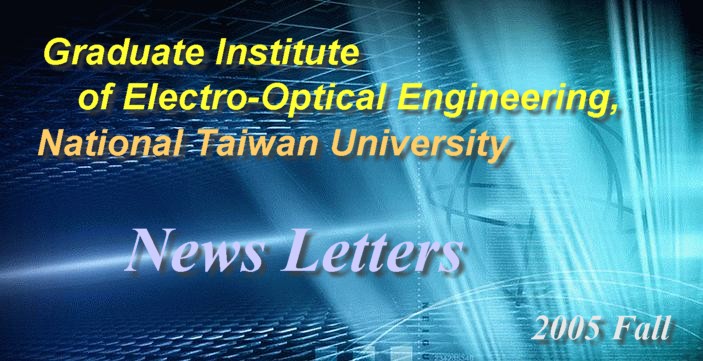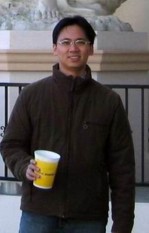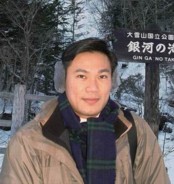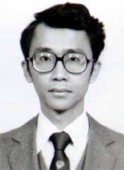
Foreword News Congratulations Visitors Profiles Laboratory Descriptions
|
Although the Graduate Institute of Electro-Optical Engineering of National Taiwan University is still a small institute, it has experienced dramatic changes in the past three years. The faculty number grew by four times, laboratory space was expanded by two and a half times, and research budget increased by four times. With the growth in all aspects, the Institute is ready to compete with other related institutions in the world. Electro-optical or photonics engineering is a key technology of the 21st century. Currently, almost all science and engineering areas require the supports of the photonics technology. The photonics technology is pioneering in its nature, as well as practical in research and development. The following are the major developments concerning the Institute in the next two years: |
|
|
1. Fostering young faculty with high standards and full supports 2. Promoting exchanges among professors and students in the international and Chinese communities 3. Collaborating with large local optoelectronics companies on large-scale research projects 4. Expanding research and application scopes of the photonics technology 5. Searching for resources, for sufficient laboratory space, and establishing large-scale joint laboratories With this quarterly News Letters, people of the related fields can gain a better understanding of the Institute's activities and developments. |
|
Seminars sponsored by the institute
![]() Cross
Taiwan-Strait Photonics Microstructure and Laser
Technology Seminar
Cross
Taiwan-Strait Photonics Microstructure and Laser
Technology Seminar
* Time: November 1-3, 2005
* Place: Room 201, Barry Lam Hall, National Taiwan University
* Sponsor: Graduate Institute of Electro-Optical Engineering, NTU
* Co-sponsor: Institute of Atomic and Molecular Sciences, Academia Sinica
* 32 speakers
* Objective: to establish a platform for exchange and scholarly interactions on photonic crystals and
microstructures, laser technology and applications, and to establish close scholarly collaborations
between Taiwan and Mainland China
|
|
|
![]() Workshop on Photonic
Crystals & Nano-photonics
Details
Workshop on Photonic
Crystals & Nano-photonics
Details
* Time: Nov. 4 (afternoon) and Nov. 5 (all day), 2005
* Place: Room 101, Barry Lam Hall, National Taiwan University
* Invited speakers: 2 IEICE Distinguished Lecturers (see below) and 16 local speakers
| Name | Affiliation | Topic |
| Kiyotoshi Yasumoto |
* Department of Computer Science and Communication Engineering, Kyushu University * Japan |
Electromagnetic analysis on photonic crystals apparatuses |
| Masaya Notomi |
* Distinguished Technical Member * NTT Basic Research Laboratories * Japan |
Developments on photonic crystals apparatuses |
|
|
|
|
|
|
![]() Dec. 23 Innovative
Photonics Technology Seminar
Details
Dec. 23 Innovative
Photonics Technology Seminar
Details
![]() The Greater Taipei Area
Electro-optical Institutes Student Event was held starting Saturday 9am on
The Greater Taipei Area
Electro-optical Institutes Student Event was held starting Saturday 9am on
October 1 in the auditorium of the First Student Activities Center. Activities included teacher and
student talent show, explanatory sessions of display technology companies, raffles and prizes. The
Greater Taipei Area Electro-optical Institutes Basketball Tournament was held at 4pm. All students
from our institute participated.
* Sponsor unit: Institute of Optoelectronic Sciences, National Taiwan Ocean University
* Participating universities: National Taiwan University, National Taiwan Normal University, National
Taiwan University of Science and Technology, National Taipei University of Technology, National
Taiwan Ocean University
 |
 |
|
|
|
| Professor Milton Feng Department of Electrical and Computer Engineering, University of Illinois IEEE and OSA Fellow Professor Milton Feng visited the institute on August 15, and gave a speech entitled, “From Transistor to Transistor Laser.” Professor Feng is an IEEE and OSA fellow and is working on transistor lasers in the U.S. with funding from DARPA.
|
|
.
 |
Jui-che Tsai Assistant Professor Graduated from the Department of Electrical Engineering of National Taiwan University in 1997, Professor Tsai received a master’s degree from the Graduate Institute of Electro-optical Engineering of NTU in 1999. After serving in Taiwan’s military for two years, he began studying for a Ph.D. degree at the University of California, Los Angeles (UCLA) in 2001. With zeal for research, in July 2005 Professor Tsai returned to his alma mater, the Graduate Institute of Electro-optical Engineering at NTU, to teach. Besides devoting his time to research, Professor Tsai enjoys baseball the most in leisure. Moreover, he delights in and immerses himself in movies and novels. Music also lights up his life with every rhythm. |
|
About one month before returning to Taiwan, Professor Tsai had a car accident on the freeway. With the memory still fresh, Professor Tsai remembered that he could not break timely, resulting in a crash that even made the air bag pop out. Fortunately Professor Tsai was not seriously hurt. He originally thought himself unfortunate to have had the accident right before leaving the States. But afterward, he thought he was extremely fortunate to come out of the accident intact. He then remembered an analogy he had heard, “If health is 1, then after every accomplishment you add a 0 after the 1. But if the 1 does not exist, any accomplishment remains 0.” He did not quite understand the reasoning behind this analogy, but now he does. Before this accident, Professor Tsai never had to use the States’ medical services; even when he had colds, he took care of himself. From the accident, he learned about the American medical system. Comparing the cost of medical services in the States and in Taiwan, it wouldn’t be exaggerating to say that the cost of medical care of the former is unbelievably expensive. An emergency treatment will incur bills from doctors, the hospital, the X-ray department, the blood test department, and more. Taiwan’s medical service is much simpler. After experiencing the accident, Professor Tsai is glad to be back in Taiwan. Professor Tsai’s research focuses on the following: Optical MEMS (Micro-Electro-Mechanical Systems), MEMS-based optical switches for telecommunication, optical systems, among others. While studying in the States, he was responsible for a research project on WDM (Wavelength Division Multiplexing) switches. He once heard someone half-jokingly said, “The entertainment field is the driving force of technological developments.” When he first heard this, he laughed. But after thinking it through, the reasoning is perhaps correct. Professor Tsai said that most technology industries that enter the consumer market directly or indirectly turn into a part of everyday life and have a firm foothold. As for dedicating himself to education, Professor Tsai believes that “Electro-optics education and the industry complement each other, but should be distinct. After students finish their studies, they don’t all have to work for the industry. And even if they do work for the industry, they would face work that is more or less different from the subjects of their specialized studies. Thus, while they are students, they should build a solid, diversified foundation to ensure a smooth change of career or study in the future.” We await eagerly for the electro-optics elites fostered by Professor Tsai and hope that the future of Taiwan’s electro-optics shines brightly! |
|
|
Ding-wei Huang Assistant Professor Graduated in 1993 from the Department of Electrical Engineering of National Taiwan University, Professor Huang received his Ph.D. degree in 1999 from the electro-optical division of the same department and university. After six months of post doctorate research at NTU, Professor Huang served at the Industrial Technology Research Institute to fulfill his military service. With a great enthusiasm for research, Professor Huang returned to our insitute in February 2005 to teach as assistant professor. Besides research, he also listens to music, plays the guitar and enjoys water sports. |
 |
| Professor Huang’s research focuses on ultra-fast lasers, optical communication systems and devices, plane waveguide devices, and more. While studying for his master’s degree, he researched and developed 35 femtosecond short pulse titanium sapphire laser, short pulse fiber lasers, fiber grating analysis, and tunable acusto-optic fiber components. When serving at the Opto-electronics and Systems Laboratories of the Industrial Technology Research Institute, Professor Huang led a team working on a research project on a key technology of optical communication. There were many breakthroughs and innovations especially on the simulation, design, fabrication, packaging, and other core technologies of plan waveguide devices. Professor Huang won the gold medal for innovative research from the Opto-electronics and Systems Laboratories, and many of his innovations have Taiwan and U.S. patents. Professor Huang believes that there are many applications in display, storage, optical communication, and optoelectronic energy of the electro-optical industry. Different industries possess their own cycles, and as time goes on, their influences increase and decrease. As long as technology understands the needs of people, consuming and entertainment trends, there is ample potential for promising products. Thus no matter what industry one is in, with a solid foundation and efforts put into application, the future is boundless in opportunities. |
|

|
Silvano Donati, Pavia University, Italy Visiting Professor Professor Silvano Donati is our guest Professor from Italy. In 1966, he received a Ph.D. degree with honors from University of Milano, Italy, and started his activity at CISE (Centro Informazioni Studi Esperienze, now ENEL) as a researcher. In 1980, he became a full professor at University of Pavia and since then he continues to devote his efforts to education. Professor Donati’s researches include the following: electro-optical instrumentation, interferometry, noise in devices and in photodetection, optical amplifiers, passive fiberoptic components, optical chaos and cryptography, and optical fiber sensors. His |
|
major accomplishments in the fields related to electro-optics include self-mixing interferometry, optical amplifier noise, optical CSK, and photodetector noise theory. For his accomplishments, he has received the Fellow Member grade from the IEEE (Institution of Electrical and Electronic Engineers, USA) and from the OSA (Optical Society of America). Along with his wife Tiziana Tambosso, Professor Donati is visiting Taiwan for the first time and has a very good impression of it. Although proficient in Italian, English, German, and French, Professor Donati hasn’t learned Chinese yet but is curious about the profound Chinese characters. Fortunately, a cosmopolitan city like Taiwan has many English signs to guide foreigners, such as the professor and his wife, so they have been able to visit and appreciate many interesting spots around the city. Since arriving in Taiwan, the professor’s deepest impression is the stark contrast of American-style modern architecture and traditional Chinese alleys situated side by side. Although from a country crazy about soccer, Professor Donati lacks an interest for this sport. He does not follow the crazy soccer fans. He believes that the enormous salaries given to the players can be better used for social and charitable purposes and research. But when talking about skiing, the professor’s eyes light up! As a ski lover, he enjoys the speed on snow, and however cold the weather is, his enthusiasm would not melt. Professor Donati also often joins his wife in diving. As a licensed diver, Mrs. Donati is like a mermaid in the sea, enjoying the beautiful views underwater. They hope they will have the chance to dive in and explore the underwater of Taiwan. Professor Donati is very concerned about safety and reminds all that one shouldn’t be alone when diving and should be aware of water pressure. Don’t forget to be safe when diving! For details of Professor Donati’s achievements, awards, projects, and publications, please see http://www.unipv.it/donati.
|
|
| Professor Way-Seen Wang Integrated Optics Laboratory Research focus: fabrication, measurement, and simulation of integrated photonic devices
|
 |
The goal of integrated photonics is to enable the generation, modulation, switching, detection, and other functions of light on one single substrate. Integrated photonic devices not only are able to contain massive information, free from electromagnetic interference, but also have the capability of parallel-processing information. The reliable devices also economically gather components onto one single chip, demonstrating the special qualities of common integrated circuits. The vibration problem in the traditional photonics laboratory completely disappears with component integration. Integrated photonic components with small geometrical sizes are better able to effectively function than traditional photonic components. For instance, a lower voltage is able to produce the necessary electro-optic effect and more efficiently use acousto-optic effect to process optical signals.
The current materials for fabricating integrated photonic components can be divided into two categories. The first group is the semi-conductor III-V materials such as gallium arsenide (GaAs), indium phosphide (InP), among others. This group of materials can emit light, and thus be made into lasers so that modulated electric signals can directly be converted into light modulation. The second group has ferroelectric crystals, like lithium niobate (LiNbO3), lithium tantalite (LiTaO3), among others. Although this group of materials does not emit light, it is great in electro-optic modulation. With waveguide fabricated on the surface and an appropriate electrode design, signal modulation at high-frequency could be achieved. This laboratory focuses on lithium-niobate integrated photonic components and other related research.
The light signals of integrated photonic devices are transmitted by waveguides, and thus waveguides are the basic components of integrated photonic devices. The following are related research topics of this laboratory:
1. Special waveguides
A. magnesium-induced lithium-outdiffused optical waveguide
B. nickel-indiffused optical waveguide
C. ridge waveguide
D. wide-bending-angle waveguide
2. Optical polarization splitter
3. Organic semiconductor nanowire
Current research topics include:
1. Blue-laser waveguide device
2. Surface plasma resonance (SPR) sensor
3. Polymer waveguide device
| Professor Hung-chun Chang Computational Photonics and Electromagnetics Laboratory Research focus: Fiber optics, optical waveguide devices and theory, computational electromagnetics for optoelectronics, lightwave technology |
 |
Professor Chang’s laboratory has recently been renamed “Computational Photonics and Electromagnetics Laboratory.” Computational electromagnetics is an area that employs numerical computation to simulate, analyze, and study various electromagnetic problems for determining the electric-field and magnetic-field distributions in spatial regions containing specific electromagnetic materials and structures. Traditionally, computational electromagnetics has been developed in the microwave areas or problems involving lower frequencies. We have for many years developed several computational electromagnetic methods for applying to problems in photonics. We study photonics problems described by Maxwell’s equations and look for numerical solutions for the electromagnetic fields. Therefore, “computational photonics” should serve as an appropriate name for our research area.
We have continual interest in various optical fibers and optical waveguides and different fiber-optic and integrated optic devices composed of such waveguides. We have established theoretical analysis models, obtained numerical solutions for the optical waveguide modes, and simulated electromagnetic wave propagation phenomena in devices, including fused fiber devices, polished fiber devices, directional coupling devices, polarization-dependent devices, grating-based devices, and more. We have also developed various beam propagation methods for analysis and design of guided-wave optical structures. Besides, for studying novel and special-tpye optical waveguide or dielectric waveguide structures having sophisticated structures, such as photonic crystal fibers, we have developed high-accuracy mode solvers based on various numerical techniques, such as finite difference methods, finite element methods, spectral methods, etc.
We have devoted to research on the new scientific topic, photonic crystals. In addition to photonic crystal fibers, we have interest in different photonic crystal structures and related devices, and the underlying physics. We develop advanced time-domain electromagnetic analysis and simulation methods for related study, such as the finite-difference time-domain (FDTD) method. Time-domain electromagnetic methods can be applied to the study of many electromagnetic problems, including reflection and scattering in complicated structures. We have also employed time-domain techniques for investigating various topics related to next generation high-density integrated photonic circuits.
There exist several commercial electromagnetic simulation softwares that are useful tools in the design and R&D of many mature device structures. However, such commercial products are not perfect tools. For certain special structures, they may not be applicable or their simulation results cannot be easily verified. For the purpose of research on special or novel structures, we in our laboratory develop suitable electromagnetic analysis methods and obtain simulation or analysis results with correctness we are sure of. Such work can have valuable contribution to academic research and students who participate in these projects can acquire in-depth understanding of electromagnetic-wave and lightwave phenomena.
| Professor Yean-Woei Kiang Photonic and Electromagnetic Simulation Laboratory Research focus: Electromagnetic simulation of electro-optical devices, simulation of optical imaging of biological tissues |
 |
In this laboratory, numerical computations are performed on computer to simulate and analyze various photonic and electromagnetic problems. For electromagnetic simulation of electro-optical devices, numerical methods are used to solve the Maxwell equations and related physical or material equations. Either linear or nonlinear phenomena of passive and active electro-optical devices are analyzed. Physical mechanisms are explored for design reference.
Professor Kiang’s past research included analyses of nonlinear coupling effect in semiconductor optical amplifiers, colliding-pulse mode-locking mechanism for semiconductor lasers, performance of semiconductor nonlinear optical loop mirrors, mode coupling effects in fiber gratings, and radiation characteristics of organic light-emitting diodes. He also used the Monte Carlo method in simulating near-IR light propagation and scattering in turbid media to develop applications in optical imaging of biological tissues. Recently, He has been interested in theoretical simulation of photonic crystals and surface plasma waves.






